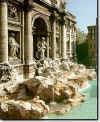|
It is one of the most
famous sights of Rome, and of the most successful monuments built in
Rome in the 18th century. The fountain was built under Clement XII in
1732-1762 by the project of N.Salvi (finished after Salvi's death by
Giuseppe Pannini), who's project was chosen among other 16. The statue
of the Ocean is by P.Bracci (1762), the rest of the sculptures and
decorative elements were executed by various sculptors. The
fountain occupies entire side of Palazzo Poli and is 20m wide and 26m
high.
- Two giant tritons conduct the winged
chariot of Neptune-Ocean. In the side niches are figures of Health (right)
and Abundance (left), both by F.Della Valle; the bas-reliefs above
represent the virgin of the legend pointing out the spring to the
soldiers, and Agrippa, approving the plans for the aqueduct. The
four statues above represent the Seasons with their gifts. At the
summit is the coat-of-arms of the Corsini family, with two
allegorical figures.
-
- Previously here was a simple
fountain by L.B.Alberti placed by Nicolas V to celebrate the
realization of his project which consisted in reactivation of
ancient aqueduct of Agrippa, Acqua Vergine, 20km long and
bringing to Rome one of the purest waters in the world. The name
"Vergine" (Virgin) derives from the history of its
discovering by a little girl in 19 b.C., who showed the water source
to the Roman soldiers. The Acqua Vergine also feeds the fountains of
Piazza Navona, Piazza di Spagna and Piazza Farnese.
-
- The name "Trevi" may
come from "tre vie", i.e. "three streets",
referring to the three roads converging here.
-
- There is a tradition that every
visitor has to through a coin to the fountain (standing with the
back facing the fountain) if they want to return to Rome one more
time. This cute superstition comes from an ancient custom when
pilgrims were leaving the coins on the tomb of St Peter. The money
from the fountain is collected periodically and donated to the
Italian Red Cross.
|
